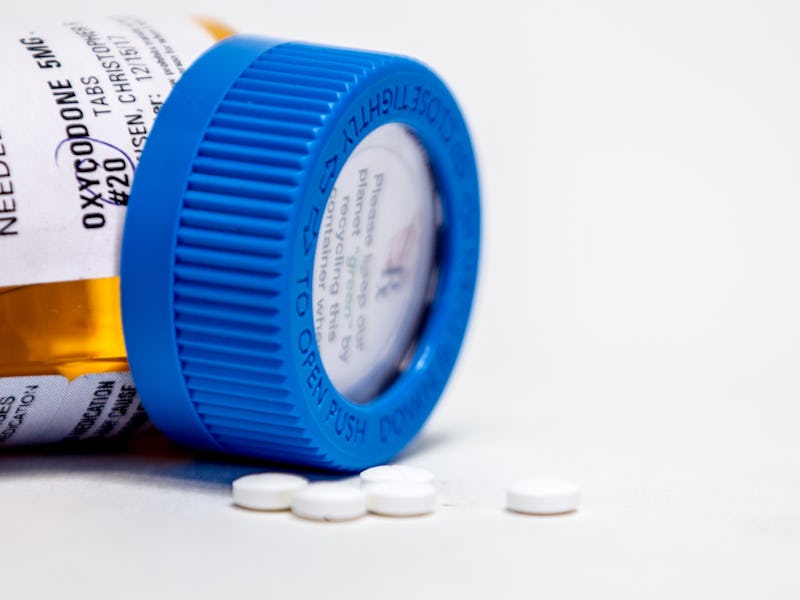The Opioid Crisis Might Hinge on Length of Drug Use, Not Dosage, Doctors Say
It's more about length of time than dosasge, say doctors.

The National Institute on Drug Abuse reports that 90 Americans die every day from opioid overdoses, both from legally prescribed drugs — oxycodone, hydrocodone, morphine, etc. — and from illegal drugs — heroin, illegal fentanyl. This overdose death rate increased 280 percent from 2002 to 2015, and by all accounts, it continues to rise. There’s no mistake: opioid abuse has become a public health crisis. And while there are many concurrent factors that contribute to the opioid crisis, including the unsupported medical claim that opioids aren’t addictive, doctors want to get a better idea of the degree to which prescribing practices can lead to drug abuse.
In a paper published Wednesday in The British Medical Journal, doctors found that patients prescribed opioid medications to manage pain after operations were much more likely to misuse the drugs the longer they took the drugs. They also found that the length of opioid use was a stronger predictor of misuse than the dose of an opioid prescription.
“Overall rates of misuse were low, but rates grew rapidly with increasing opioid use,” write the study’s authors.
Doctors say opioid misuse is closely related to the length of time someone takes a prescribed drug.
To conduct this research, the team, composed of doctors at Harvard Medical School, the University of Florida, and Johns Hopkins University, along with a data analyst at health insurer Aetna, examined medical records of over one million patients who had had operations. These patients weren’t already taking opioids at the time of their operations and had no documented history of opioid misuse. Out of these patients, 568,612 (56 percent) received post-operative opioid prescriptions. 90 percent filled their prescriptions within three days of leaving the hospital.
Of this group, 5,906 (0.6 percent) had insurance diagnosis codes that indicated signs of misuse, including opioid dependence, abuse, or overdose. It’s a relatively low number, which supports the argument that medical prescribing isn’t the main driver of the opioid crisis.
The study’s authors then analyzed the drug dosages and the number of prescription refill patterns for these patients, and they found that the rate of opioid misuse doubled with a single refill. They also found that each prescription refill translated to a 44 percent higher rate of misuse and each week of use was associated with a 20 percent higher chance of misuse.
Doctors say the longer a patient takes opioids after surgery, the more likely it is that they'll misuse the drugs.
“These findings suggest a more nuanced understanding of the relation between duration and dosage,” write the study’s authors. These findings, they say, suggest that the optimal way to prescribe opioid drugs after operations, such that pain relief is maximized and misuse risk is minimized, “may be achieved with moderate to high opioid dosages at shorter durations, a combination that merits further investigation in population based and clinical studies.”
Abstract:
OBJECTIVE To quantify the effects of varying opioid prescribing patterns after surgery on dependence, overdose, or abuse in an opioid naive population.
DESIGN Retrospective cohort study.
SETTING Surgical claims from a linked medical and pharmacy administrative database of 37651619 commercially insured patients between 2008 and 2016.
PARTICIPANTS 1,015,116 opioid naive patients undergoing surgery.
MAIN OUTCOME MEASURES Use of oral opioids after discharge as defined by refills and total dosage and duration of use. The primary outcome was a composite of misuse identified by a diagnostic code for opioid dependence, abuse, or overdose.
RESULTS 568,612 (56.0%) patients received postoperative opioids, and a code for abuse was identified for 5,906 patients (0.6%, 183 per 100,000 person years). Total duration of opioid use was the strongest predictor of misuse, with each refill and additional week of opioid use associated with an adjusted increase in the rate of misuse of 44.0% (95% confidence interval 40.8% to 47.2%, P<0.001), and 19.9% increase in hazard (18.5% to 21.4%, P<0.001), respectively.
CONCLUSIONS Each refill and week of opioid prescription is associated with a large increase in opioid misuse among opioid naive patients. The data from this study suggest that duration of the prescription rather than dosage is more strongly associated with ultimate misuse in the early postsurgical period. The analysis quantifies the association of prescribing choices on opioid misuse and identifies levers for possible impact.